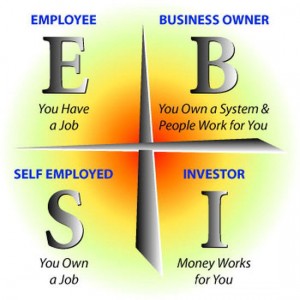
Why You Need More “Employees”
This post may contain links from our sponsors. We provide you with accurate, reliable information. Learn more about how we make money and select our advertising partners.
Using Robert Kiyosaki's Rich Dad, Poor Dad's Cash Flow Quadrant to justify why we should stay in the “Investor” box to earn passive income, White Coat Investor validates how to become wealthy with more “employees.”
Today’s Classic is republished from White Coat Investor. You can see the original here.
Enjoy!
You need more employees.
Let me tell you about the best kind of employees out there. The best employees never take a bathroom or smoke break. They work just as hard at the end of the day as at the beginning. In fact, they work 24 hours a day, 7 days a week, and 365 days a year. They never get sick, hurt, or take a vacation. They require no benefits, worker’s comp insurance, or even payroll taxes. Who are these employees? These are the dollars you earned but did not spend, i.e. your investments.
The Value of Your Investment “Employees”
Any given one of these “employees” might not be particularly profitable. They might only be good for a nickel, or perhaps, if you’re lucky, a dime each year. But when you have 500,000 of them or better yet 2,000,000 of them, those nickels and dimes really add up. At a dime apiece, those two million employees are the equivalent of a physician's income.
Tax Benefits of Your Investment “Employees”
One of the best parts of these special “employees” is that they face a much lower tax burden than that physicians. For example, physicians earning $200,000 per year not only will be paying taxes at a Federal marginal rate as high as 32% and a state marginal rate as high as 9% but will also be paying payroll taxes.
Your “employee dollars,” however, may be paying as little as 15% at qualified dividend or long-term capital gains tax rates. Perhaps less if sheltered by depreciation. Perhaps nothing if those “employees” are working in a tax-free account such as a Roth IRA. And no matter where they are located, none of them will be paying any payroll taxes at all.
The Cash Flow Quadrant
This seems like a good time to bring up Robert Kiyosaki’s famous Cash Flow Quadrant. Now, no matter what you may think of Kiyosaki (and admittedly my opinion isn’t all that high) and his (probably) fake Rich Dad, this is a useful concept to understand. Here it is:

The Employee
Starting on the upper left is the “Employee” Box. This beats not being in any box at all because at least you have an income. The problem with being an employee is one that many physicians can appreciate. Your income tends to be VERY highly taxed and you have little control over how you do your job, whether or not you are fired, your tax burden, and your benefits package.
The Self-Employed
The “Self-Employed” box has numerous benefits over the “Employee” box. When you move into this box, you get to keep the profit you generate. Remember no employee is ever paid what he is worth, if he were, there would be no point in hiring him if he costs just as much profit as he generates.
The Self-Employed can’t be fired (except by his clients!) He gets to pick (and pay for) his own benefits package, but has a great deal more control over his tax burden, with more write-offs and better retirement plans. You own your job, but you still have to go to work.
The Business Owner
The “Business Owner” box represents an improvement over the “Self-Employed” box in that the business makes money even when the owner isn’t there. Sure, there may be some great effort in getting the business started, and maybe even some invested capital, but a certain amount of money coming out of the business is passive. You own the job AND don’t have to go to work every day.
A C Corporation business structure also provides a few tax benefits that the typical self-employed business structures (sole proprietors, LLCs, S corps) do not. Essentially, when you own a business, you get to pay all your expenses first and then pay taxes, as opposed to the employee situation, where you pay taxes then pay all your expenses. A subtle difference, but it adds up quickly, especially if you’re willing to be creative and aggressive on your taxes.
The Investor
Kiyosaki’s “Investor” box is his ideal. This situation is that which I began this post with, where you have hundreds of thousands of little “employees” running around earning nickels and dimes on their own each year. You don’t have to go to work at all!
There are also lots of great tax benefits including retirement accounts, depreciation with real estate investments, tax-loss harvesting, the step-up in basis at death, the donation of appreciated shares to charity, and lower tax rates. But the best part is that it is all (mostly) passive income, meaning you don’t have to work for it. True capitalism if you will.
How to Convert Earned Income to Passive Income
The way to get wealthy is to take your earned (and thus highly taxed) income and convert it to investments as quickly as possible. Essentially, you’re moving your money from the Employee and Self-Employed box to the Business Owner and Investments box.
How do you do that? First, you must carve out a significant portion of your income with which to build wealth (I generally recommend 20% for docs.) Then you must invest it in a reasonable manner. Then leave it alone and let it work. Before long, you may find that you have hundreds of thousands of employees providing you with more income than you can generate on your own, no matter how hard you work.
What do you think? What do you do for passive income? How have you found success moving from the “employee” box to the others?
Find the Passive Income Docs FB group to share! But before that… be sure to subscribe to White Coat Investor's e-blast for secret posts you can't find online!

Disclaimer: The topic presented in this article is provided as general information and for educational purposes. It is not a substitute for professional advice. Accordingly, before taking action, consult with your team of professionals.

